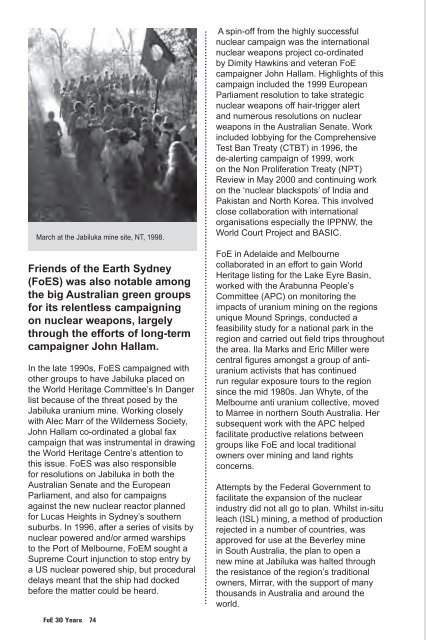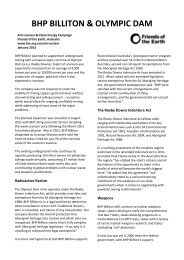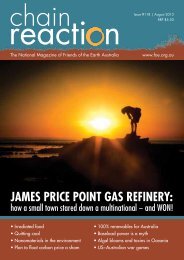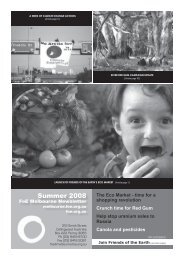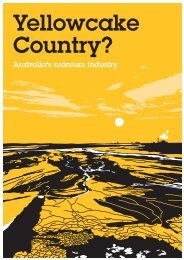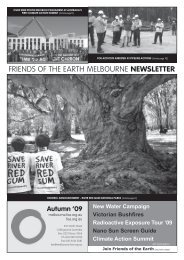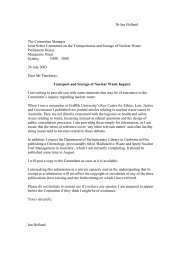Thirty Years of Creative Resistance - Friends of the Earth Australia
Thirty Years of Creative Resistance - Friends of the Earth Australia
Thirty Years of Creative Resistance - Friends of the Earth Australia
Create successful ePaper yourself
Turn your PDF publications into a flip-book with our unique Google optimized e-Paper software.
March at <strong>the</strong> Jabiluka mine site, NT, 1998.<br />
<strong>Friends</strong> <strong>of</strong> <strong>the</strong> <strong>Earth</strong> Sydney<br />
(FoES) was also notable among<br />
<strong>the</strong> big <strong>Australia</strong>n green groups<br />
for its relentless campaigning<br />
on nuclear weapons, largely<br />
through <strong>the</strong> efforts <strong>of</strong> long-term<br />
campaigner John Hallam.<br />
In <strong>the</strong> late 1990s, FoES campaigned with<br />
o<strong>the</strong>r groups to have Jabiluka placed on<br />
<strong>the</strong> World Heritage Committee’s In Danger<br />
list because <strong>of</strong> <strong>the</strong> threat posed by <strong>the</strong><br />
Jabiluka uranium mine. Working closely<br />
with Alec Marr <strong>of</strong> <strong>the</strong> Wilderness Society,<br />
John Hallam co-ordinated a global fax<br />
campaign that was instrumental in drawing<br />
<strong>the</strong> World Heritage Centre’s attention to<br />
this issue. FoES was also responsible<br />
for resolutions on Jabiluka in both <strong>the</strong><br />
<strong>Australia</strong>n Senate and <strong>the</strong> European<br />
Parliament, and also for campaigns<br />
against <strong>the</strong> new nuclear reactor planned<br />
for Lucas Heights in Sydney’s sou<strong>the</strong>rn<br />
suburbs. In 1996, after a series <strong>of</strong> visits by<br />
nuclear powered and/or armed warships<br />
to <strong>the</strong> Port <strong>of</strong> Melbourne, FoEM sought a<br />
Supreme Court injunction to stop entry by<br />
a US nuclear powered ship, but procedural<br />
delays meant that <strong>the</strong> ship had docked<br />
before <strong>the</strong> matter could be heard.<br />
...................................................................................................................................................................................................<br />
A spin-<strong>of</strong>f from <strong>the</strong> highly successful<br />
nuclear campaign was <strong>the</strong> international<br />
nuclear weapons project co-ordinated<br />
by Dimity Hawkins and veteran FoE<br />
campaigner John Hallam. Highlights <strong>of</strong> this<br />
campaign included <strong>the</strong> 1999 European<br />
Parliament resolution to take strategic<br />
nuclear weapons <strong>of</strong>f hair-trigger alert<br />
and numerous resolutions on nuclear<br />
weapons in <strong>the</strong> <strong>Australia</strong>n Senate. Work<br />
included lobbying for <strong>the</strong> Comprehensive<br />
Test Ban Treaty (CTBT) in 1996, <strong>the</strong><br />
de-alerting campaign <strong>of</strong> 1999, work<br />
on <strong>the</strong> Non Proliferation Treaty (NPT)<br />
Review in May 2000 and continuing work<br />
on <strong>the</strong> ‘nuclear blackspots’ <strong>of</strong> India and<br />
Pakistan and North Korea. This involved<br />
close collaboration with international<br />
organisations especially <strong>the</strong> IPPNW, <strong>the</strong><br />
World Court Project and BASIC.<br />
FoE in Adelaide and Melbourne<br />
collaborated in an effort to gain World<br />
Heritage listing for <strong>the</strong> Lake Eyre Basin,<br />
worked with <strong>the</strong> Arabunna People’s<br />
Committee (APC) on monitoring <strong>the</strong><br />
impacts <strong>of</strong> uranium mining on <strong>the</strong> regions<br />
unique Mound Springs, conducted a<br />
feasibility study for a national park in <strong>the</strong><br />
region and carried out field trips throughout<br />
<strong>the</strong> area. Ila Marks and Eric Miller were<br />
central figures amongst a group <strong>of</strong> antiuranium<br />
activists that has continued<br />
run regular exposure tours to <strong>the</strong> region<br />
since <strong>the</strong> mid 1980s. Jan Whyte, <strong>of</strong> <strong>the</strong><br />
Melbourne anti uranium collective, moved<br />
to Marree in nor<strong>the</strong>rn South <strong>Australia</strong>. Her<br />
subsequent work with <strong>the</strong> APC helped<br />
facilitate productive relations between<br />
groups like FoE and local traditional<br />
owners over mining and land rights<br />
concerns.<br />
Attempts by <strong>the</strong> Federal Government to<br />
facilitate <strong>the</strong> expansion <strong>of</strong> <strong>the</strong> nuclear<br />
industry did not all go to plan. Whilst in-situ<br />
leach (ISL) mining, a method <strong>of</strong> production<br />
rejected in a number <strong>of</strong> countries, was<br />
approved for use at <strong>the</strong> Beverley mine<br />
in South <strong>Australia</strong>, <strong>the</strong> plan to open a<br />
new mine at Jabiluka was halted through<br />
<strong>the</strong> resistance <strong>of</strong> <strong>the</strong> region’s traditional<br />
owners, Mirrar, with <strong>the</strong> support <strong>of</strong> many<br />
thousands in <strong>Australia</strong> and around <strong>the</strong><br />
world.<br />
FoE 30 <strong>Years</strong> 74


